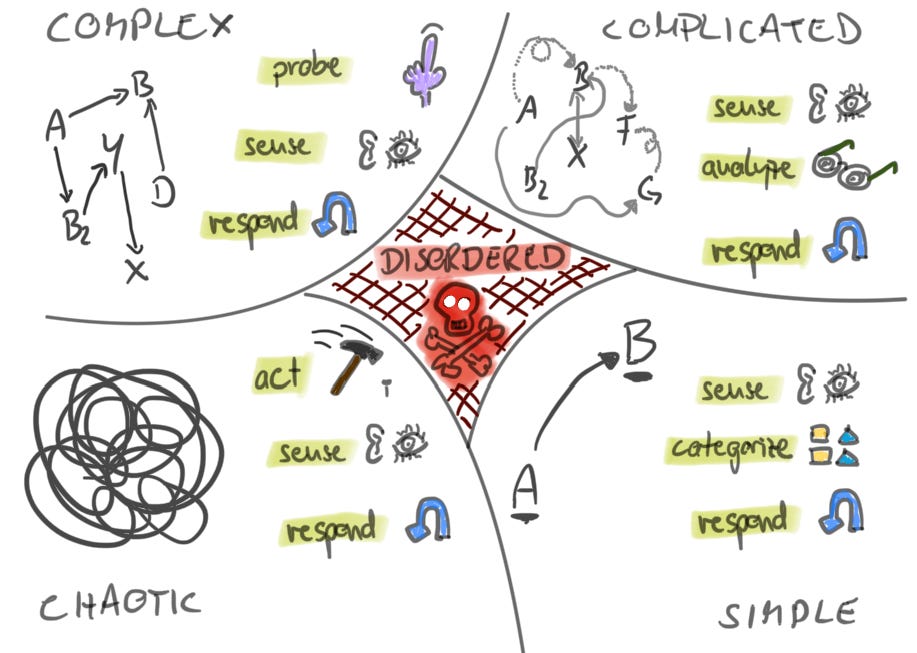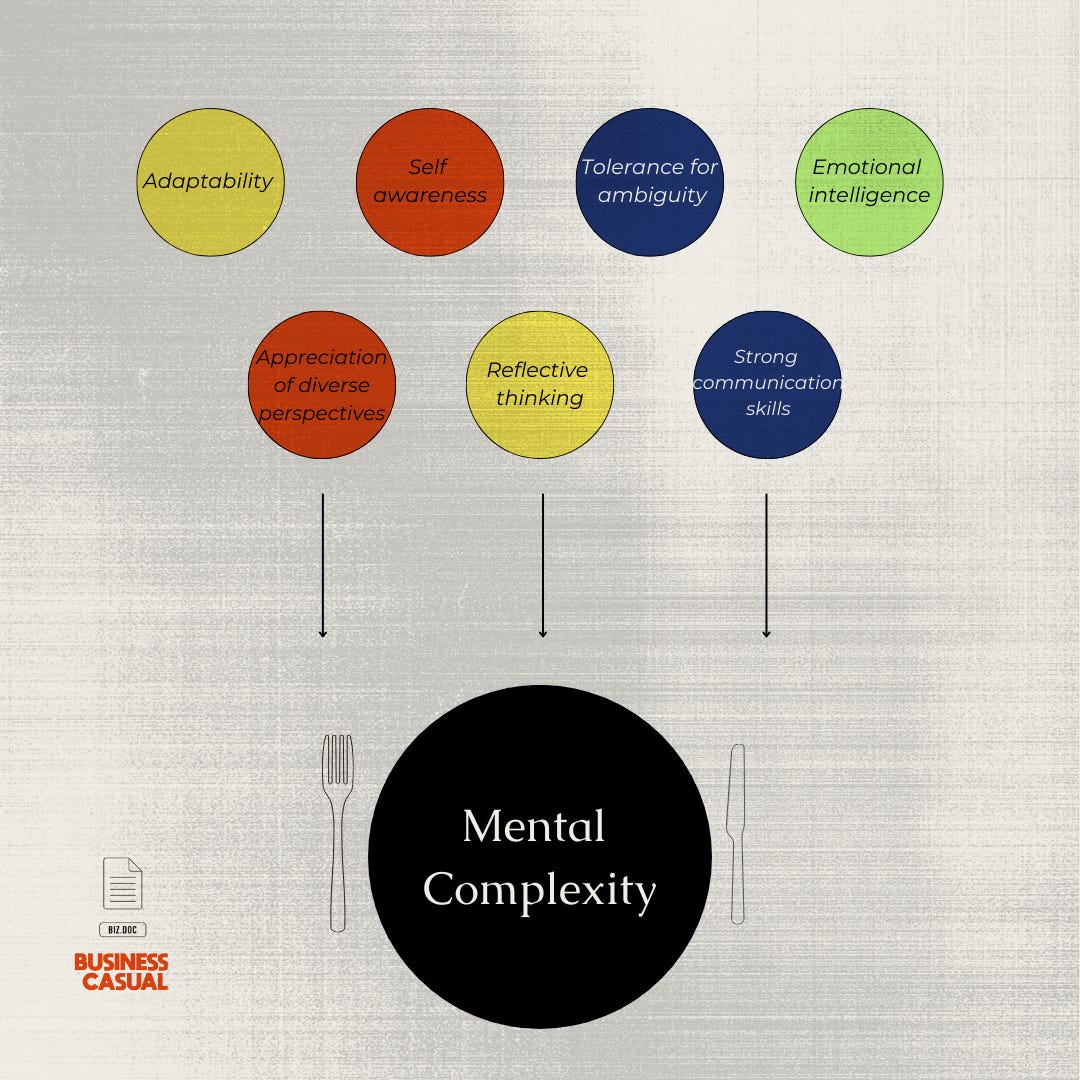"Instability has become a defining feature of our times. In many ways, this instability is the new landscape." -movement generation.org
In an era where change is ceaseless (no matter how tired we are) and complexity is the rule, our ability to adapt and solve problems has become paramount. The challenges we confront, whether in our careers or daily lives, often exceed the bounds of simplicity. They require a form of problem-solving that delves deeper and broader.
As I read that paragraph back, it really sounds as though I'm about to present you with a magical insight or tool that will immediately solve all the complex problems you face daily. But you're smarter than that, so instead, I want to share some information on why you find it challenging (just like everyone else leading a team) and how you could begin to build up your tolerance for ambiguity (more on why you need that later.)
Is it simple, complicated, complex, or just chaotic?
In a world filled with quotes about embracing problems, I think first, it's important to know that problems come in all shapes and sizes, and until you see what you're dealing with, it's hard to embrace it or even find a path forward.
This framework can help you.
It's called the "Cynefin framework," a decision and sense-making model developed by Dave Snowden. He created it to help people and organizations orient themselves to better understand their problems and hopefully solve them effectively.
Simple
In this domain, problems are well-defined, and there is a clear cause-and-effect relationship.
Complicated
Problems are still defined in this domain, but there may be multiple right answers, and expertise is required to analyze and address them.
Complex
Multiple interacting factors and a lack of clear cause-and-effect relationships characterize complex problems. Solutions are emergent and unpredictable.
Chaotic
There is no clear relationship between cause and effect in chaotic situations, and problems require immediate, rapid responses to regain control.
Lucky for us, many of the problems we face at work are complex.
Take remote and hybrid work, for example. On the surface, it may seem like a simple problem; we need the right systems or tools in place. Now, more than three years in, we know it's much more complex than that. It involves redefining professional and personal life boundaries, recalibrating communication methods and workflows, nurturing team dynamics across distances, and adapting leadership styles to manage a dispersed workforce. The complexities extend beyond technology and logistics to encompass the essence of work culture, human behavior, and the psychology of remote productivity.
And that's a lot.
The precursor to solving complex problems
Have you ever heard of the cooking term "mise on place"? It means "putting in place" or "gathering"; essentially, it refers to the setup required before you can even begin cooking. Solving problems well is in a lot of ways, like cooking. You actually need to gather quite a few skills before you can solve complex issues proficiently.
Enter mental complexity. I first heard about it in the book, "Immunity To Change."
In essence, mental complexity is how well a person can process and understand the world around them. It's not a fixed trait but can develop through experiences, education, and self-awareness. It's influenced by factors like education, life experiences, exposure to diverse perspectives, and your willingness to engage in cognitive growth and self-reflection.
You can see all of the varying skills required in mental complexity here.
For so long, we’ve thought the key to solving complex work problems was gaining more technical experience. While those skills are helpful and necessary, there are also so many other important ways to practice your mental complexity.
Serving as a mediator or conflict resolver in workplace disputes.
Leading a diverse team with members from various backgrounds and working styles requires mental complexity.
Managing change within an organization, team, or project involves addressing multifaceted challenges, whether it's a new technology implementation or a cultural shift.
Can we befriend ambiguity?
"You don't have to see the whole staircase; just take the first step." -Martin Luther King
Embracing ambiguity at work is a challenge for so many of us. It’s rooted in human psychology and, even more so, the dynamics of the modern workplace. Our natural desire for certainty and fear of the unknown often leads us to resist uncertainty. This resistance is further fueled by risk aversion, cognitive dissonance, and the need for control. In a results-oriented culture, ambiguity can be perceived as an obstacle to efficiency and success. Not to mention, a lack of training, performance evaluation pressures, and the avoidance of failure will ultimately inhibit our ability to navigate uncertain terrain comfortably.
To foster a culture that thrives in ambiguity, organizations and leaders like you have to begin encouraging learning from failure, providing support, and promoting a mindset that values experimentation. In the meantime, you can develop your tolerance for ambiguity by gradually exposing yourself to uncertainty and actively seeking self-improvement. In a world that grows increasingly complex, the ability to embrace ambiguity is a vital skill, enabling innovation, adaptability, and resilience in the face of uncertainty.
I tend not to love listicles, but I want you to see how many ways you can begin to practice mental complexity.
Practice Systems Thinking: Systems thinking encourages you to view problems holistically, understanding the interconnections and interdependencies within complex systems. Practice identifying feedback loops, non-linear relationships, and unintended consequences in various contexts.
Seek Diverse Perspectives: Engage with people from different backgrounds, cultures, and professions. Actively listen and learn from their viewpoints. A diversity of perspectives can enrich your thinking and challenge your assumptions.
Challenge Your Assumptions: Be willing to question your own beliefs and assumptions. Consider alternative viewpoints and solutions, and explore the reasons behind your choices.
Practice Reflective Thinking: Set aside time for reflection. Regularly contemplate your experiences, decisions, and thought processes. This self-reflection can enhance your ability to make sense of complex situations.
Develop Emotional Intelligence: Understand and manage your emotions and those of others. Emotional intelligence helps you navigate complex social and interpersonal situations with empathy and insight.




